Abstract
To provide more detailed information about Candida epidemiology and pathogenesis in pediatric burn patients, Candida isolates from 113 patients collected over 3 years were identified at the species level and the serotypes and biotypes of the C. albicans isolates were determined. A total of 85% of the patients were colonized or infected by C. albicans, 18% by C. tropicalis, and 11% by C. parapsilosis. Although colonization or infection often was found at multiple sites and times, 87% of the patients were colonized or infected by only one Candida species or strain; the other 13% showed multiple colonizations or infections, some of which occurred simultaneously at the same site. C. albicans biotyping determined the tolerance of the isolates to pH (pH 1.4) and salt; flucytosine, borate, and safranine resistance; and ability to produce proteinase and assimilate urea, sorbose, and citrate; results are expressed as three-digit numbers. For isolates from three different anatomical sites, the distribution of the nine biotype characteristics was similar in all cases but one. Significantly more fecal than wound or throat isolates were resistant to safranine. Sixty-four different serotype-biotype combinations were found in the 96 patients with C. albicans infections or colonizations. Twenty-nine percent of all C. albicans isolates had the partial biotype -57, while 20 of the 96 patients had specifically serotype B, biotype 557 colonizations or infections. Eleven patients had the B557 infection when admitted; nine patients acquired the yeast in-house. Thirty percent of the C. albicans isolated from 23 adult patients at a nearby hospital also showed the -57 biotype pattern, suggesting that C. albicans isolates expressing this biotype are either extremely prevalent in nature or are more virulent than other C. albicans isolates.
Full text
PDF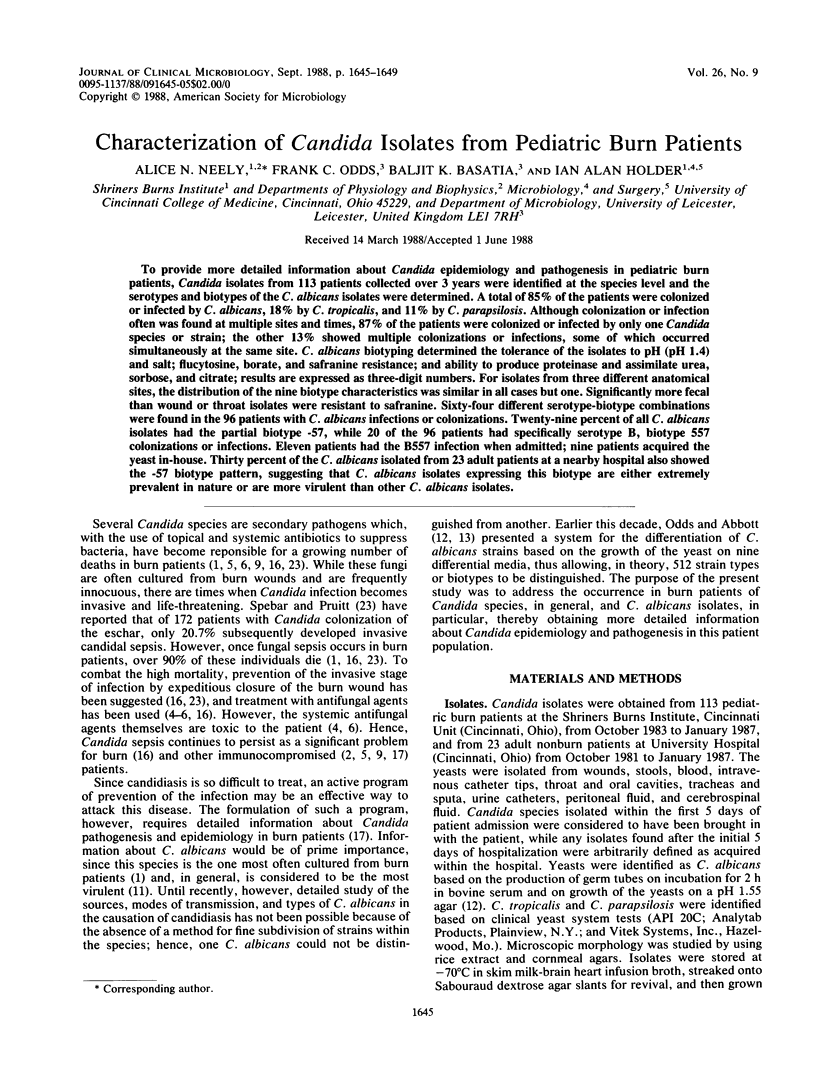
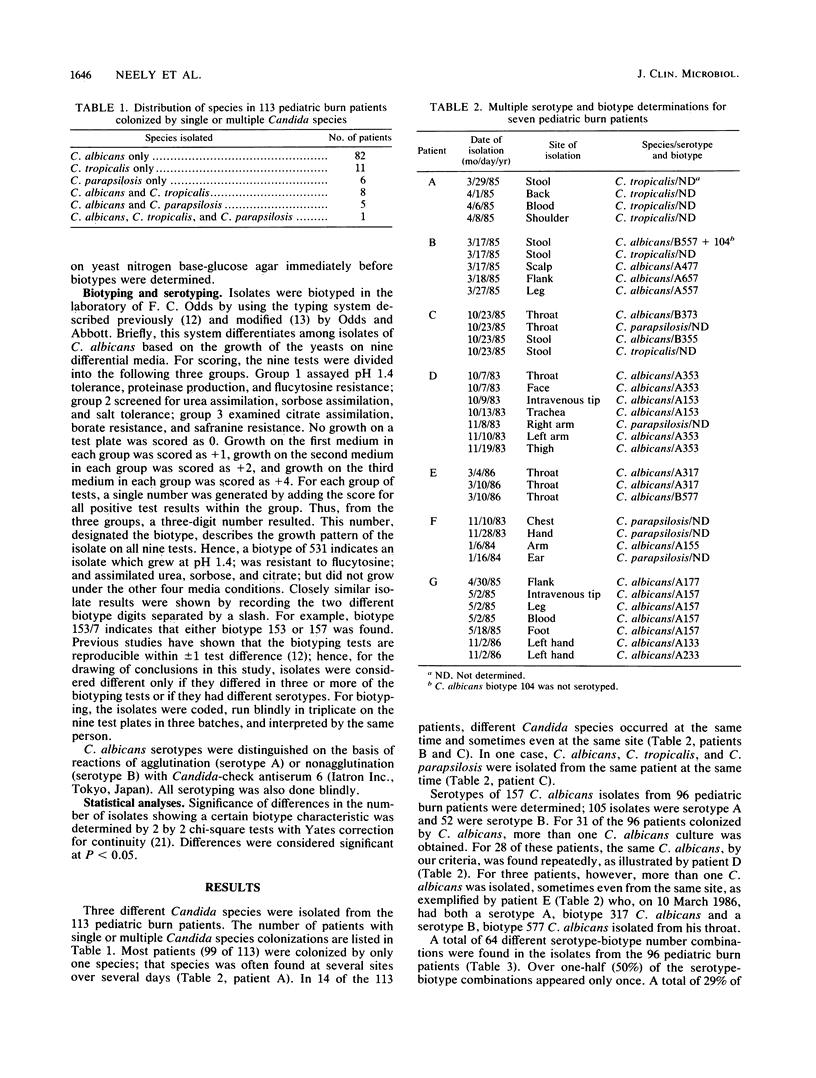
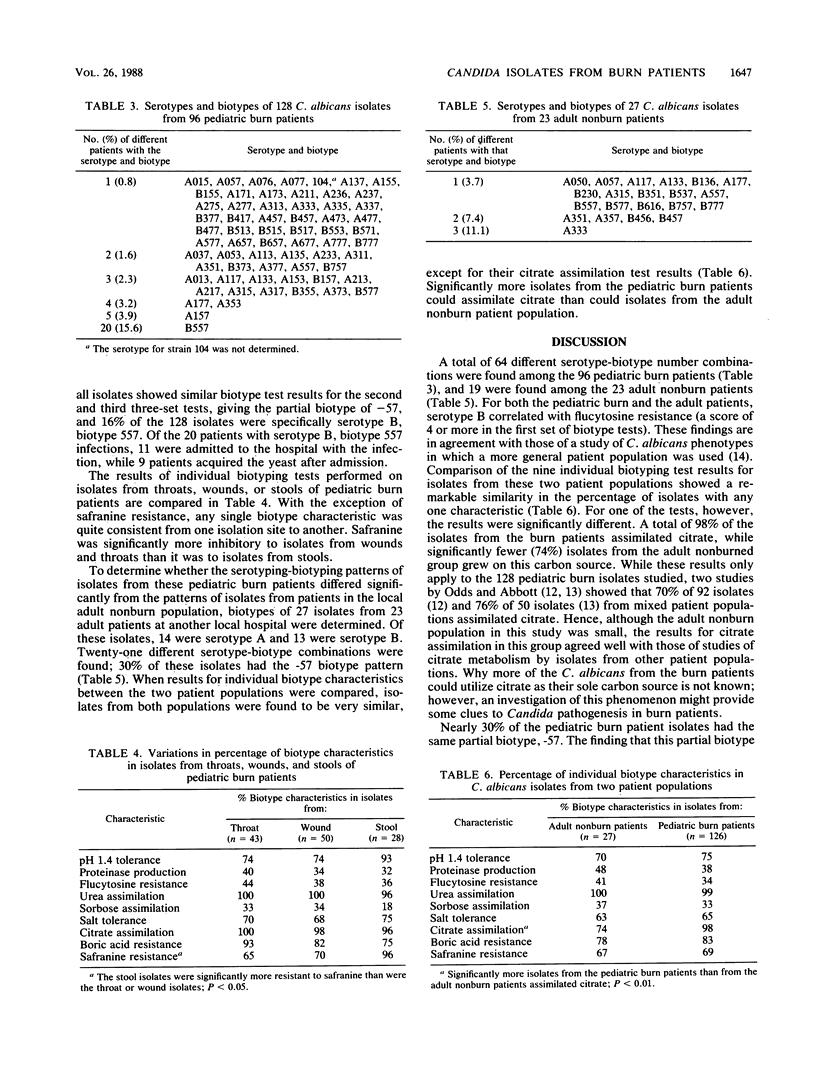
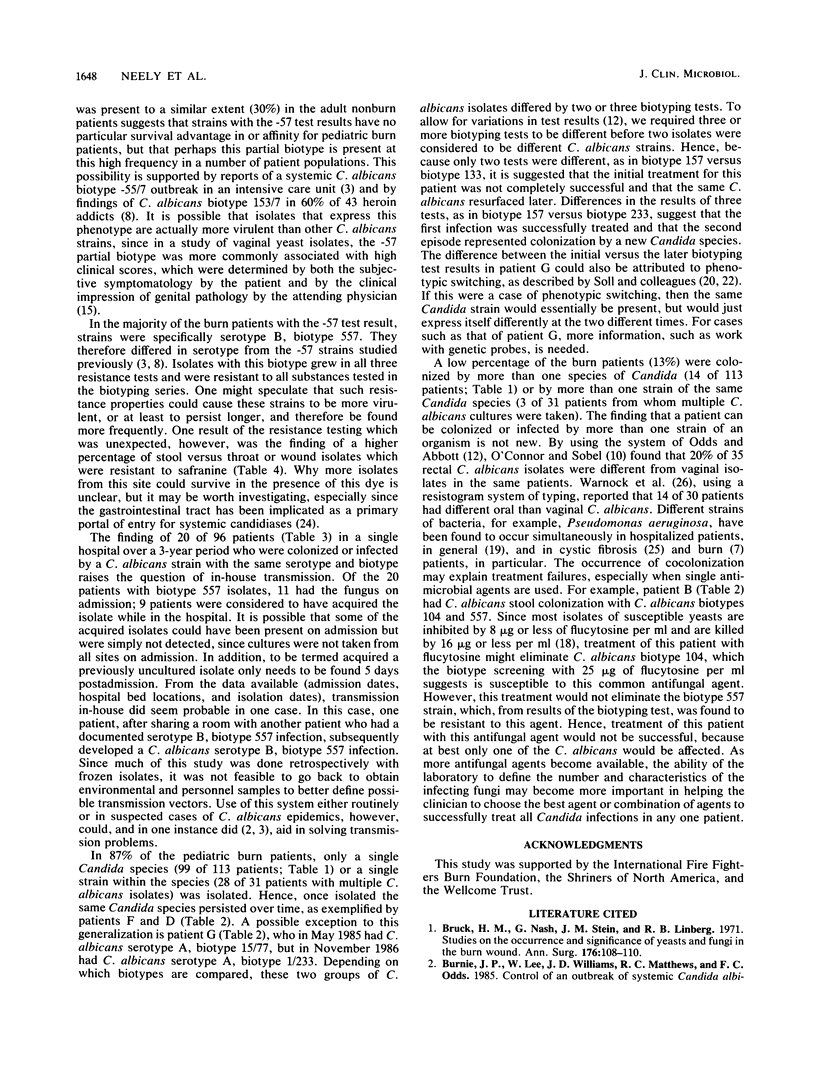
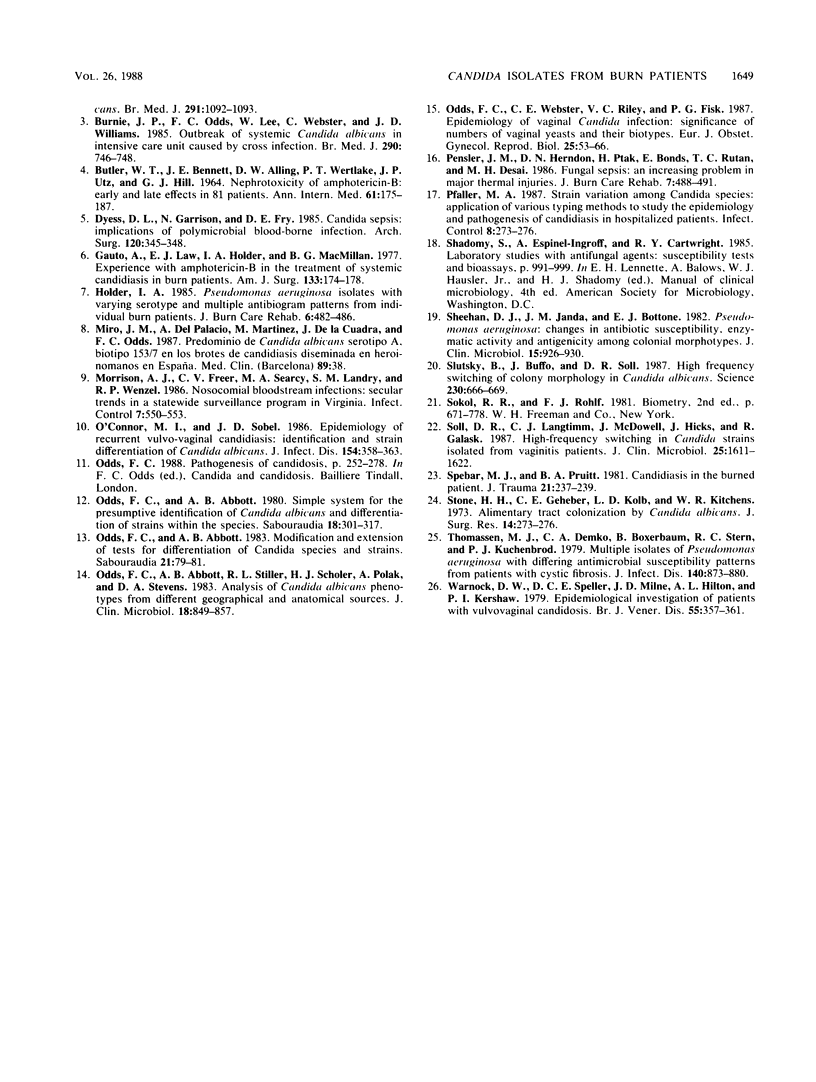
Selected References
These references are in PubMed. This may not be the complete list of references from this article.
- BUTLER W. T., BENNETT J. E., ALLING D. W., WERTLAKE P. T., UTZ J. P., HILL G. J., 2nd NEPHROTOXICITY OF AMPHOTERICIN B; EARLY AND LATE EFFECTS IN 81 PATIENTS. Ann Intern Med. 1964 Aug;61:175–187. doi: 10.7326/0003-4819-61-2-175. [DOI] [PubMed] [Google Scholar]
- Bruck H. M., Nash G., Stein J. M., Lindberg R. B. Studies on the occurrence and significance of yeasts and fungi in the burn wound. Ann Surg. 1972 Jul;176(1):108–110. doi: 10.1097/00000658-197207000-00019. [DOI] [PMC free article] [PubMed] [Google Scholar]
- Burnie J. P., Lee W., Williams J. D., Matthews R. C., Odds F. C. Control of an outbreak of systemic Candida albicans. Br Med J (Clin Res Ed) 1985 Oct 19;291(6502):1092–1093. doi: 10.1136/bmj.291.6502.1092-a. [DOI] [PMC free article] [PubMed] [Google Scholar]
- Burnie J. P., Odds F. C., Lee W., Webster C., Williams J. D. Outbreak of systemic Candida albicans in intensive care unit caused by cross infection. Br Med J (Clin Res Ed) 1985 Mar 9;290(6470):746–748. doi: 10.1136/bmj.290.6470.746. [DOI] [PMC free article] [PubMed] [Google Scholar]
- Dyess D. L., Garrison R. N., Fry D. E. Candida sepsis. Implications of polymicrobial blood-borne infection. Arch Surg. 1985 Mar;120(3):345–348. doi: 10.1001/archsurg.1985.01390270083014. [DOI] [PubMed] [Google Scholar]
- Gauto A., Law E. J., Holder I. A., MacMillan B. G. Experience with amphotericin-B in the treatment of systmeic candidiasis in burn patients. Am J Surg. 1977 Feb;133(2):174–178. doi: 10.1016/0002-9610(77)90074-5. [DOI] [PubMed] [Google Scholar]
- Holder I. A. Pseudomonas aeruginosa isolates with varying serotype and multiple antibiogram patterns from individual burn patients. J Burn Care Rehabil. 1985 Nov-Dec;6(6):482–486. doi: 10.1097/00004630-198511000-00005. [DOI] [PubMed] [Google Scholar]
- Miró J. M., del Palacio Herranz A., Martínez Ortiz de Zárate M., de la Cuadra J., Odds F. C. Predominio de Candida albicans serotipo A, biotipo 15 3/7 en los brotes de candidiasis diseminada en heroinómanos en España. Med Clin (Barc) 1987 May 30;89(1):38–38. [PubMed] [Google Scholar]
- Morrison A. J., Jr, Freer C. V., Searcy M. A., Landry S. M., Wenzel R. P. Nosocomial bloodstream infections: secular trends in a statewide surveillance program in Virginia. Infect Control. 1986 Nov;7(11):550–553. doi: 10.1017/s0195941700065309. [DOI] [PubMed] [Google Scholar]
- O'Connor M. I., Sobel J. D. Epidemiology of recurrent vulvovaginal candidiasis: identification and strain differentiation of Candida albicans. J Infect Dis. 1986 Aug;154(2):358–363. doi: 10.1093/infdis/154.2.358. [DOI] [PubMed] [Google Scholar]
- Odds F. C., Abbott A. B. A simple system for the presumptive identification of Candida albicans and differentiation of strains within the species. Sabouraudia. 1980 Dec;18(4):301–317. [PubMed] [Google Scholar]
- Odds F. C., Abbott A. B. Modification and extension of tests for differentiation of Candida species and strains. Sabouraudia. 1983 Mar;21(1):79–81. doi: 10.1080/00362178385380111. [DOI] [PubMed] [Google Scholar]
- Odds F. C., Abbott A. B., Stiller R. L., Scholer H. J., Polak A., Stevens D. A. Analysis of Candida albicans phenotypes from different geographical and anatomical sources. J Clin Microbiol. 1983 Oct;18(4):849–857. doi: 10.1128/jcm.18.4.849-857.1983. [DOI] [PMC free article] [PubMed] [Google Scholar]
- Odds F. C., Webster C. E., Riley V. C., Fisk P. G. Epidemiology of vaginal Candida infection: significance of numbers of vaginal yeasts and their biotypes. Eur J Obstet Gynecol Reprod Biol. 1987 May;25(1):53–66. doi: 10.1016/0028-2243(87)90092-x. [DOI] [PubMed] [Google Scholar]
- Pensler J. M., Herndon D. N., Ptak H., Bonds E., Rutan T. C., Desai M. H., Abston S. Fungal sepsis: an increasing problem in major thermal injuries. J Burn Care Rehabil. 1986 Nov-Dec;7(6):488–491. [PubMed] [Google Scholar]
- Pfaller M. A. Strain variation among Candida species: application of various typing methods to study the epidemiology and pathogenesis of candidiasis in hospitalized patients. Infect Control. 1987 Jul;8(7):273–276. doi: 10.1017/s0195941700066224. [DOI] [PubMed] [Google Scholar]
- Sheehan D. J., Janda J. M., Bottone E. J. Pseudomonas aeruginosa: changes in antibiotic susceptibility, enzymatic activity, and antigenicity among colonial morphotypes. J Clin Microbiol. 1982 May;15(5):926–930. doi: 10.1128/jcm.15.5.926-930.1982. [DOI] [PMC free article] [PubMed] [Google Scholar]
- Slutsky B., Buffo J., Soll D. R. High-frequency switching of colony morphology in Candida albicans. Science. 1985 Nov 8;230(4726):666–669. doi: 10.1126/science.3901258. [DOI] [PubMed] [Google Scholar]
- Soll D. R., Langtimm C. J., McDowell J., Hicks J., Galask R. High-frequency switching in Candida strains isolated from vaginitis patients. J Clin Microbiol. 1987 Sep;25(9):1611–1622. doi: 10.1128/jcm.25.9.1611-1622.1987. [DOI] [PMC free article] [PubMed] [Google Scholar]
- Spebar M. J., Pruitt B. A., Jr Candidiasis in the burned patient. J Trauma. 1981 Mar;21(3):237–239. doi: 10.1097/00005373-198103000-00007. [DOI] [PubMed] [Google Scholar]
- Stone H. H., Geheber C. E., Kolb L. D., Kitchens W. R. Alimentary tract colonization by Candida albicans. J Surg Res. 1973 Apr;14(4):273–276. doi: 10.1016/0022-4804(73)90028-0. [DOI] [PubMed] [Google Scholar]
- Thomassen M. J., Demko C. A., Boxerbaum B., Stern R. C., Kuchenbrod P. J. Multiple of isolates of Pseudomonas aeruginosa with differing antimicrobial susceptibility patterns from patients with cystic fibrosis. J Infect Dis. 1979 Dec;140(6):873–880. doi: 10.1093/infdis/140.6.873. [DOI] [PubMed] [Google Scholar]
- Warnock D. W., Speller C. D., Milne J. D., Hilton A. L., Kershaw P. I. Epidemiological investigation of patients with vulvovaginal candidosis. Application of a resistogram method for strain differentiation of Candida albicans. Br J Vener Dis. 1979 Oct;55(5):357–361. doi: 10.1136/sti.55.5.357. [DOI] [PMC free article] [PubMed] [Google Scholar]


